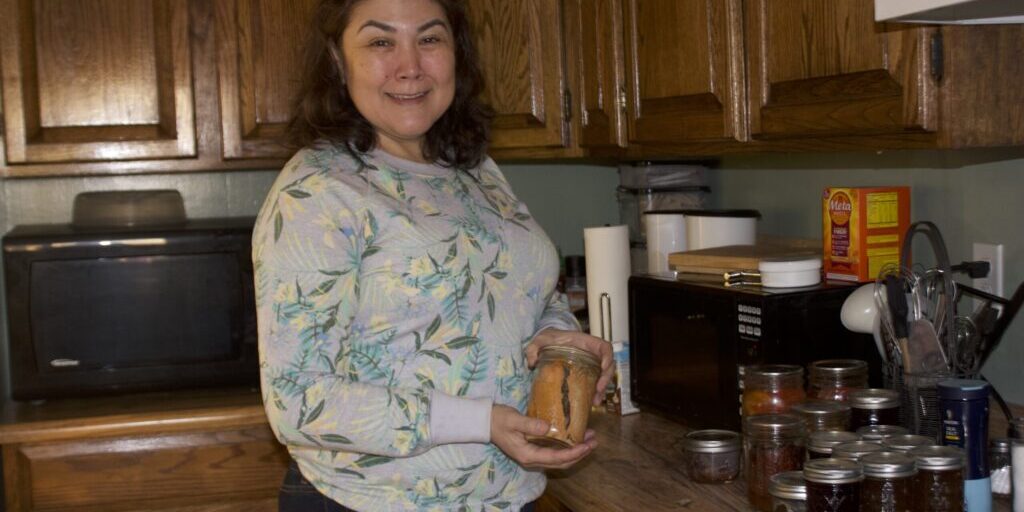The Bering Strait region is severely overcrowded as defined by the Department of Housing and Urban Development. One Nome resident saw a way she could help more people get roofs over their heads using a creative model.
KNOM recently went on a tour of “Kugzruk Kommons”, a place the owner describes as Nome’s newest common house.
Janice Wilson starts the tour by making tea in the kitchen.
“And I love that the kitchen is so large that all the tenants can come in and do as they wish. There’s enough space!”
The “Kommons” used to be a local Baptist church on 3rd Avenue. That church was built in the traditional medieval style; in the shape of a cross. Now the long vertical arm of the cross has been converted to eleven single-occupancy bedrooms while the shorter, horizontal arm has space for the kitchen, bathrooms, a spacious common area, and laundry. They’re not traditional apartments, it’s more like a boarding house, or as Wilson calls it, “a common house”.
Wilson purchased the space in November and got to construction right away. She had planned to start renting rooms by February but folks around Nome had other ideas.
“And they’re like, ‘no’. We want to move in now. And I said, ‘Ok, if you’re willing!’ All the tenants here are absolutely comfortable and I’m comfortable with them.”
All 11 rooms are already fully booked. That may be due, in part, to an overcrowded region where housing can be hard to find.
“We’re sort of locked into what a house, or what an apartment requires. There’s a full spectrum of needs.”
– Sue Steinacher
Sue Steinacher of Nome is a longtime regional housing advocate and former NEST housing specialist. There’s a need, she says, for all types of housing in Nome: ranging from affordable rent for families, to housing for working professionals. But there can be a range of options to consider.
Steinacher says restoring old homes, securing grants for housing, and building new homes in town can be prohibitively expensive. Outsiders to the region may not understand that, she explains.
“It’s the cost of getting materials in. And then it’s the cost of supporting workers if you need to bring workers in. It’s also the cost of expanding the powerlines, the sewer system, and the roads.”
The Kommons already had small rooms built-in and is hooked up to city utilities; making it easier to transition from an old church to living units.
Wilson says the Kommons is meant to be a place where someone can show up with just a suitcase. The rooms are furnished with beds, a lamp, and shelves. The kitchen is stocked with the essentials like bags of flour, sugar, coffee, and tea. Wilson says furniture and household donations from the community have helped her go far on a shoestring budget.

The linoleum floors are still being installed as of early January and small bits of furnishing are still coming in.
“I’m just so excited for all of it to come together and then people will be able to just come and sit with me during the day or the evening.”
– Janice Wilson
Wilson envisions people coming out of their rooms to spend time watching TV or playing games together. And it’s that sense of community she wants to cultivate. Afterall, she’s living there too in a converted loft apartment on the third floor.
When Wilson moved to Nome three years ago, she saw that people needed more than just a roof over their heads.
“It’s transitional housing meant for people that are in between homes and that they can find someplace before they find a home in Nome. I want people to come in and see what it feels like to be loved and cared for and in a home that provides all the necessities so that when they go to their own home, they can do the same thing.”
She’s especially hopeful that it can help inform some of the young adult residents who haven’t yet had their own home to run.
The Kommons aren’t funded by any specific grant so Wilson is paying the mortgage on her own, which means residents do have to be employed. There’s flexibility there too, like with one resident who cleans in exchange for a room.
And although her vision is transitional housing, she says some people have already decided they’re in it for the long-haul and that’s fine with her. The idea was natural to Wilson; it’s how she grew up in her village of Nondalton in the Bristol Bay Region.
“My parents invited people to stay with us and get back on their feet and when they did, they took off! It’s kind of something I’ve done my entire life and now I’m doing it again.”
This is a lifelong dream for Janice Wilson, who is Inupiaq and Athabascan. As the building became a reality, she immediately saw a way to honor the region and her family who inspired her.
“The name comes from my mother’s side of the family. It is her maiden name, which came from the Northern region of the Bering Straits: Wales and Shishmaref. Kugzruk Kommons just flowed with me. It was one of the first names that came to mind, it was perfect!”
Wilson has more dreams for housing in Nome, but for now she’ll focus on laying down the linoleum inside the Kugzruk Kommons.
Image at top: Owner of the Kugzruk Kommons, Janice Wilson shares canned salmon and other homemade goods in the community kitchen. Photo from Emily Hofstaedter, KNOM (2020).




